New concept of using VoIP on the example of Wi-Fi IP-phone Escene WS220-N
Our world is becoming more and more "wireless." Wireless mice and keyboards, wireless printers and headsets have appeared in the offices. Until recently, IP telephones remained one of the groups of devices that have not yet abandoned the wires.

Today we look at the IP-phone Escence WS220-N , which opens up new possibilities for using VoIP, which were previously unavailable in fixed IP phones at a relatively low cost for a phone of this class.
The device is identical to the popular model of a series of corporate phones Escene ES220 , but has a key feature - the presence of a wireless network interface IEEE 802.11 b / g / n.
')
Connecting the phone to the network via Wi-Fi significantly increases the flexibility of the connection - increasing mobility and ease of telephony deployment. Using cordless phones to easily organize a workplace without wires, one can cite a lot of examples where connecting phones and workplaces over a wireless network is, if not the only way out, then a highly desirable option.
For example, the construction of a LAN (local area network) is impossible or undesirable, for economic reasons, or there is already a local area network. A good example is the need for high mobility and speed of network deployment to a working state. Also, the wireless connection of the workplace can be useful for aesthetic reasons, for example, a minimum of wires and objects in the workplace. When holding time-limited events, it’s easier, faster and more convenient to deploy a wireless network. If employees often move from office to office, transporting the “network with you” is just as easy using cordless phones.
Work at home is becoming more and more common: many people need a laptop and an IP phone connected to the network to complete the work. This is where the problem arises: if all laptops have been connected via Wi-Fi for a long time, the need to pull the wire from the router hanging in the hallway under the ceiling to the kitchen becomes a problem. This is where the landline Wi-Fi IP phone helps.
Of course, there are wireless solutions on the market - VoIP-DECT phones, but they are less convenient to work in a stationary workplace, and are intended for employees who move most of the time, for example, within the enterprise.
Using a Wi-Fi IP phone , you can connect any computer to the network, without laying cables to the workplace.
Stationary workplace - in this place the computer (desktop or laptop) does not have a wireless interface (Wi-Fi adapter), then the Ethernet network cable connects to the computer, on the other hand, the PC port of the wireless IP phone, then the phone connects via Wi-Fi to router or access point.
Mobile workplace - all devices in this place have wireless interfaces: a computer (desktop or laptop) and a wireless IP phone are connected via Wi-Fi to a router or access point.
As an IP PBX can be used either its own PBX or service provided by the provider.
IP PBX companies - software or hardware and software platform located in the company's office (for example, Asterisk, 3CX, etc.)
Cloud IP PBX - a platform located at a service provider (for example, MTT, Telphin, Mango, Tekmi, etc.)
Phone Escene WS220-N has an attractive appearance and a wide range of additional functions, while the product retains an attractive price. When developing phones, engineers and designers from Escence used a unified approach to design, functional characteristics, as well as to control interfaces. The line includes two models - basic and advanced, but they are united by similar features - they meet high requirements and have all the necessary functions of IP phones of the corporate level.
The Escene WS220-N phone is a basic model and is aimed at corporate consumers who place high demands on the appearance of the phones, the quality of workmanship and usability while maintaining a reasonable cost.
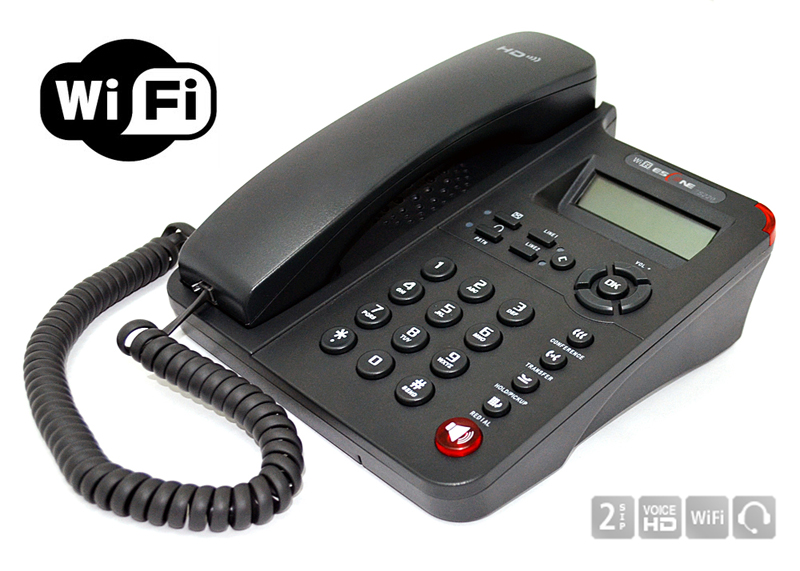
Features:
The cost of the model WS220-N is about 5,000 rubles, which is cheaper than counterparts from other manufacturers.
Functionality:
VoIP
Data transfer
Physical parameters
Additional services (additional features)
Control
Nutrition

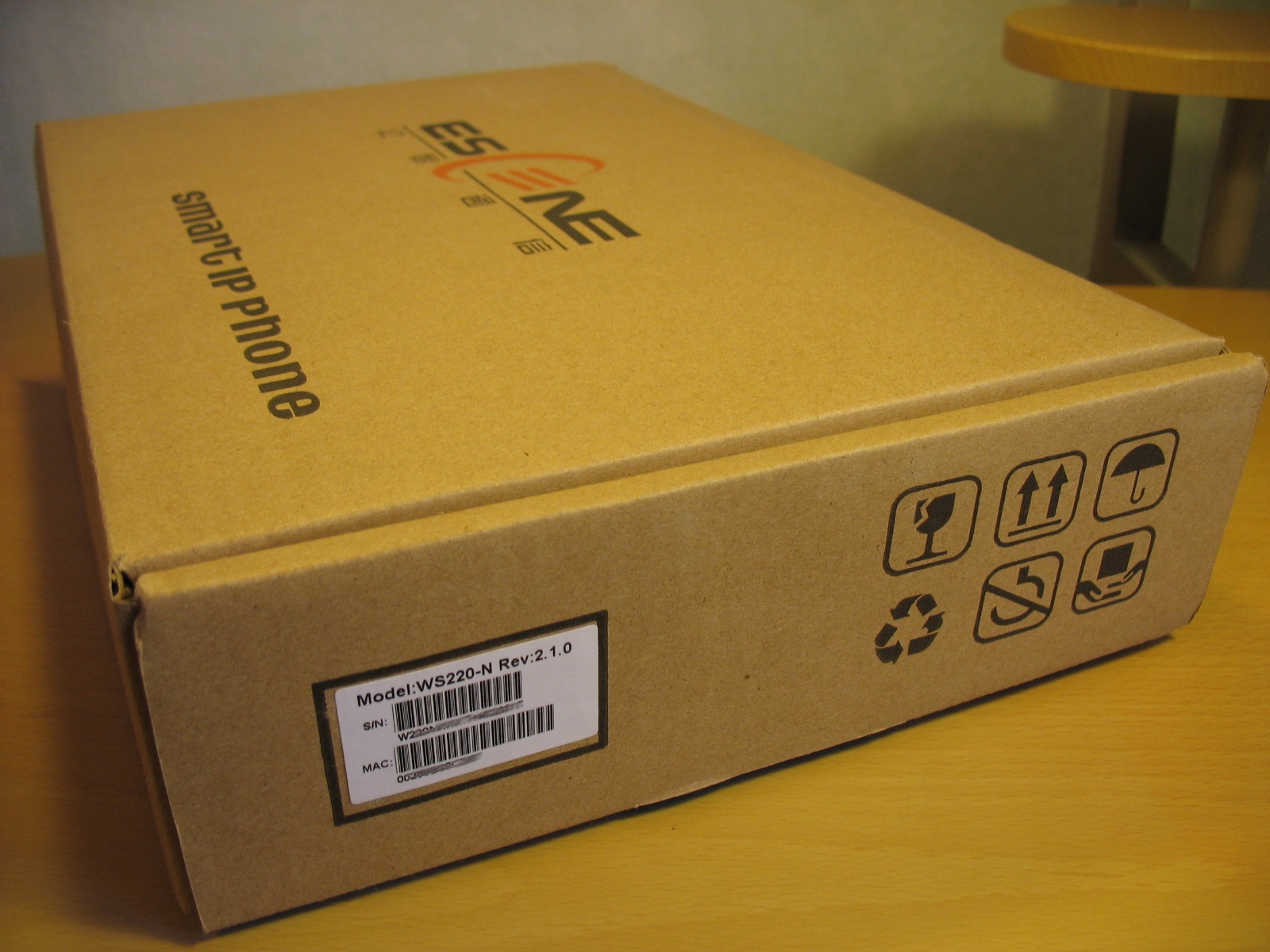
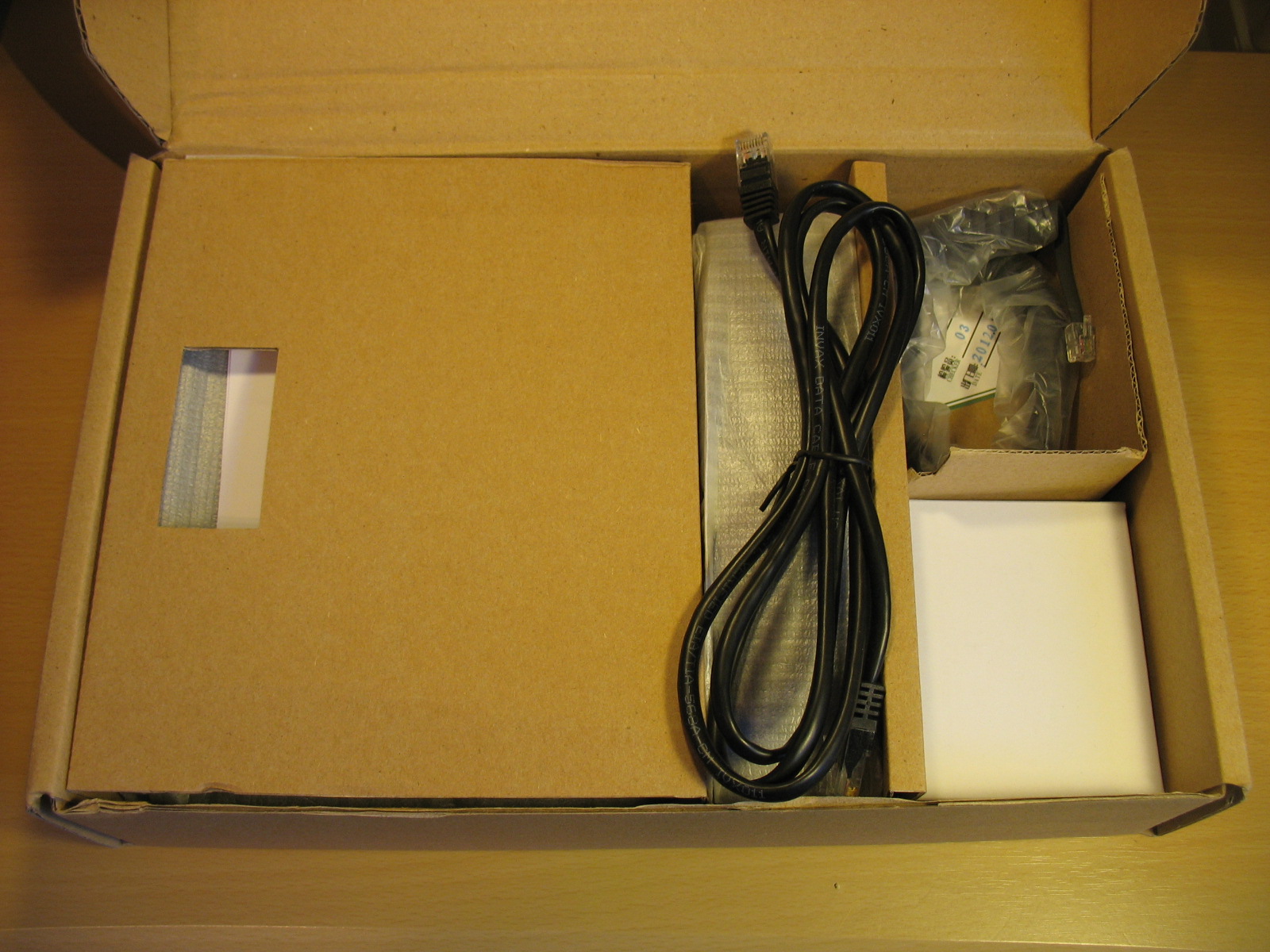

Inside the phone is neatly packed, there is nothing superfluous in the box, obviously, this equipment reduces the cost of the phone.
The box contains standard equipment, which includes:


Conventionally, the buttons on the phone can be divided into 3 blocks.
The first block is the management of lines and headset.
The phone has two independent SIP accounts (two SIP lines). By default, outgoing calls are established from line 1, if of course it is set up, if necessary to make a call from line 2, you need to click on the line button, then dial the number — the phone will send the call through the second SIP account. The phone can accept two simultaneous calls. Near the Line 1 and Line 2 buttons there is a light indication, when a call arrives, the diode of the line to which the call is being received lights up. There is a separate voice mail call button and a very useful button (the headset icon is displayed above it) to switch to the headset and back, the button also has an indicator light, which allows the operator to control whether the headset is on or off.
The second block is multifunctional navigation keys.
The block is used primarily for easy navigation through the menu, the “C” button is used to delete a character, it also turns off and turns on the microphone during a call. Using the Up and Down buttons, you can adjust the ring volume or the volume of the phone during a call.
The third block is the management of additional functions.
Here are all the necessary buttons, just the ones that are used most often:
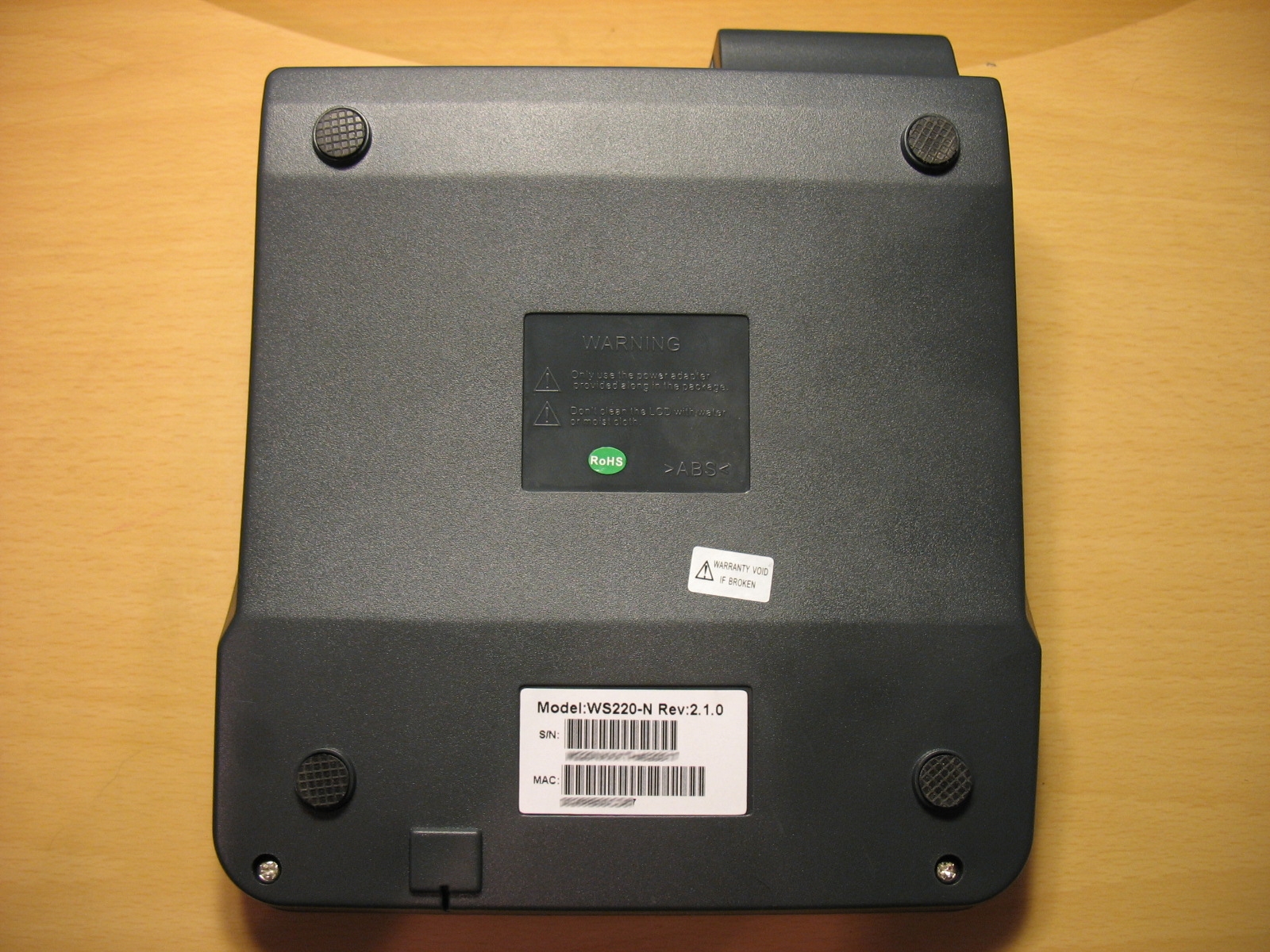
On the back of the phone is a standard sticker with the model number, serial number and MAC address.
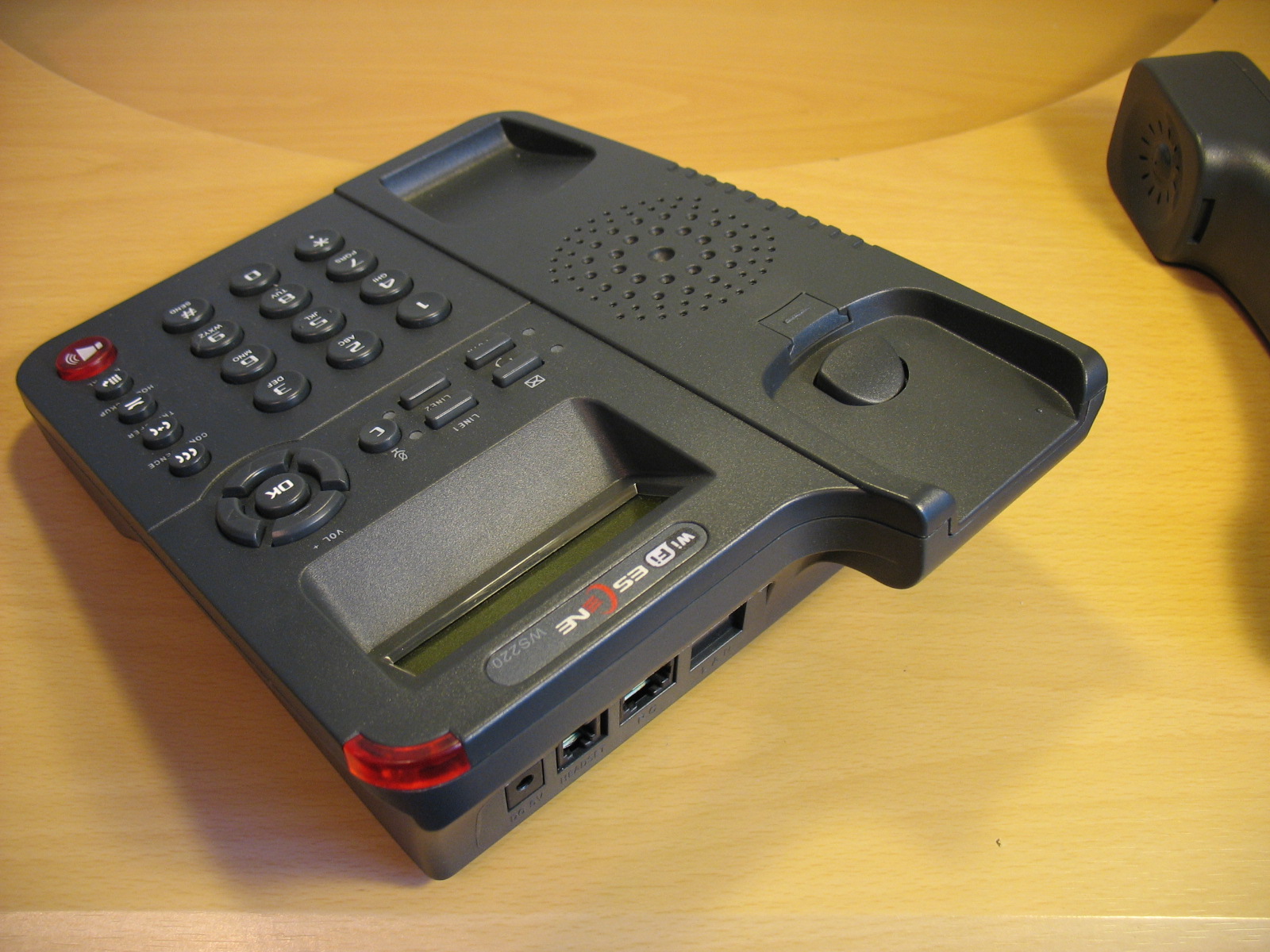
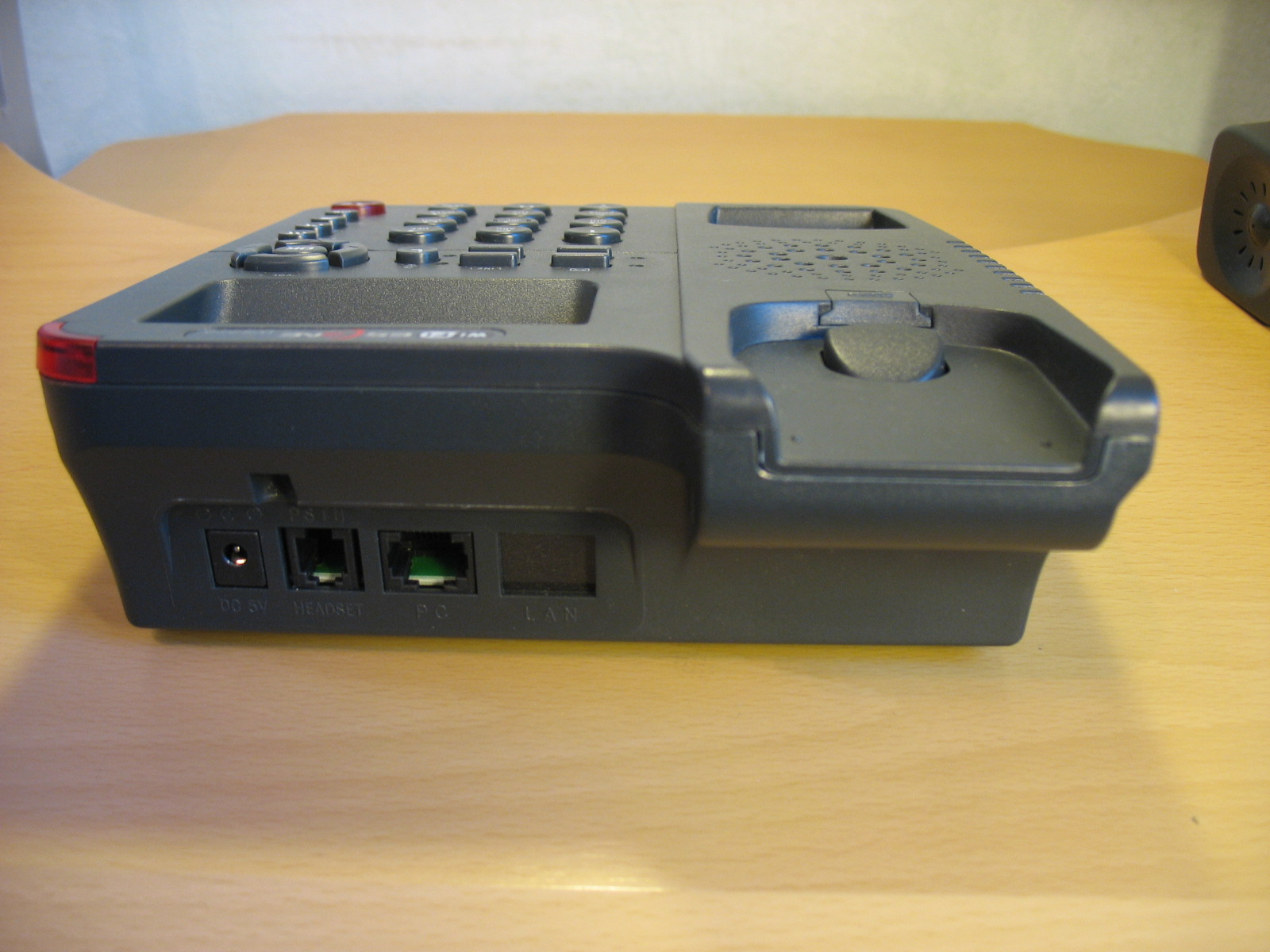

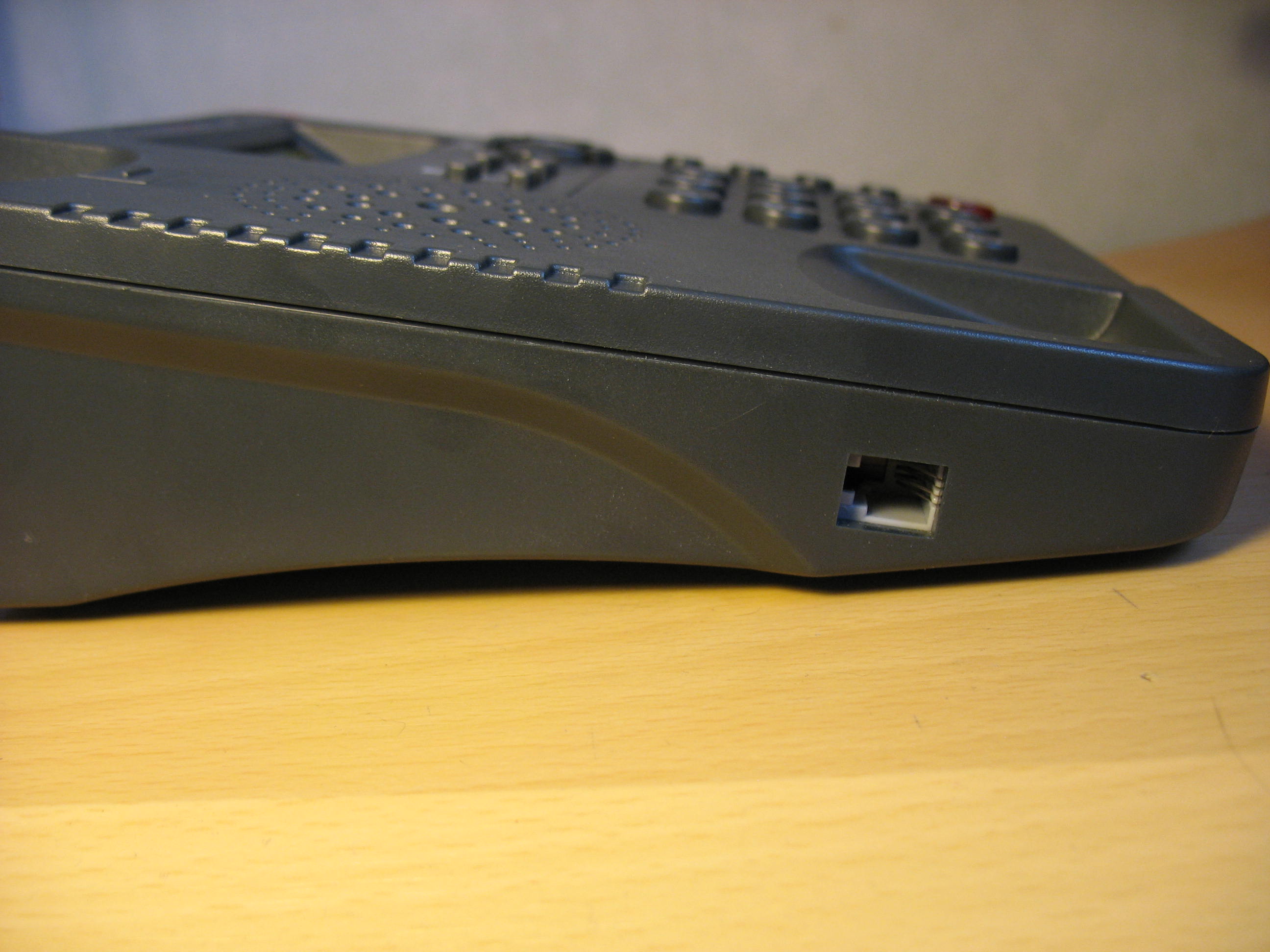
The left figure shows the side interface unit; there is a 5 volt socket on the panel for power supply from the AC network using the power adapter, and an RJ11 connector is used to connect the headset. Ethernet interface - PC for connecting the phone to a computer, there is a stub on the LAN port, as the LAN port is connected wirelessly. The picture on the right shows the RJ11 tube connector.

Here is the panel with the connected wires.


This is how the phone looks assembled, high-quality plastic, the screen backlight is not very bright, but bright enough to easily read the messages on the screen.
The phone has a monochrome LCD screen with a backlight of 128 * 32 characters, not large, but its size is enough to easily read the information from the screen.

This is how the phone screen with the registered line in Russian looks. “Line 1 (10)” is an arbitrary label that is configured in the “SIP Accounts” menu and is called “Label”. The sign of the back arrow on the screen to the right means that the forwarding is set.

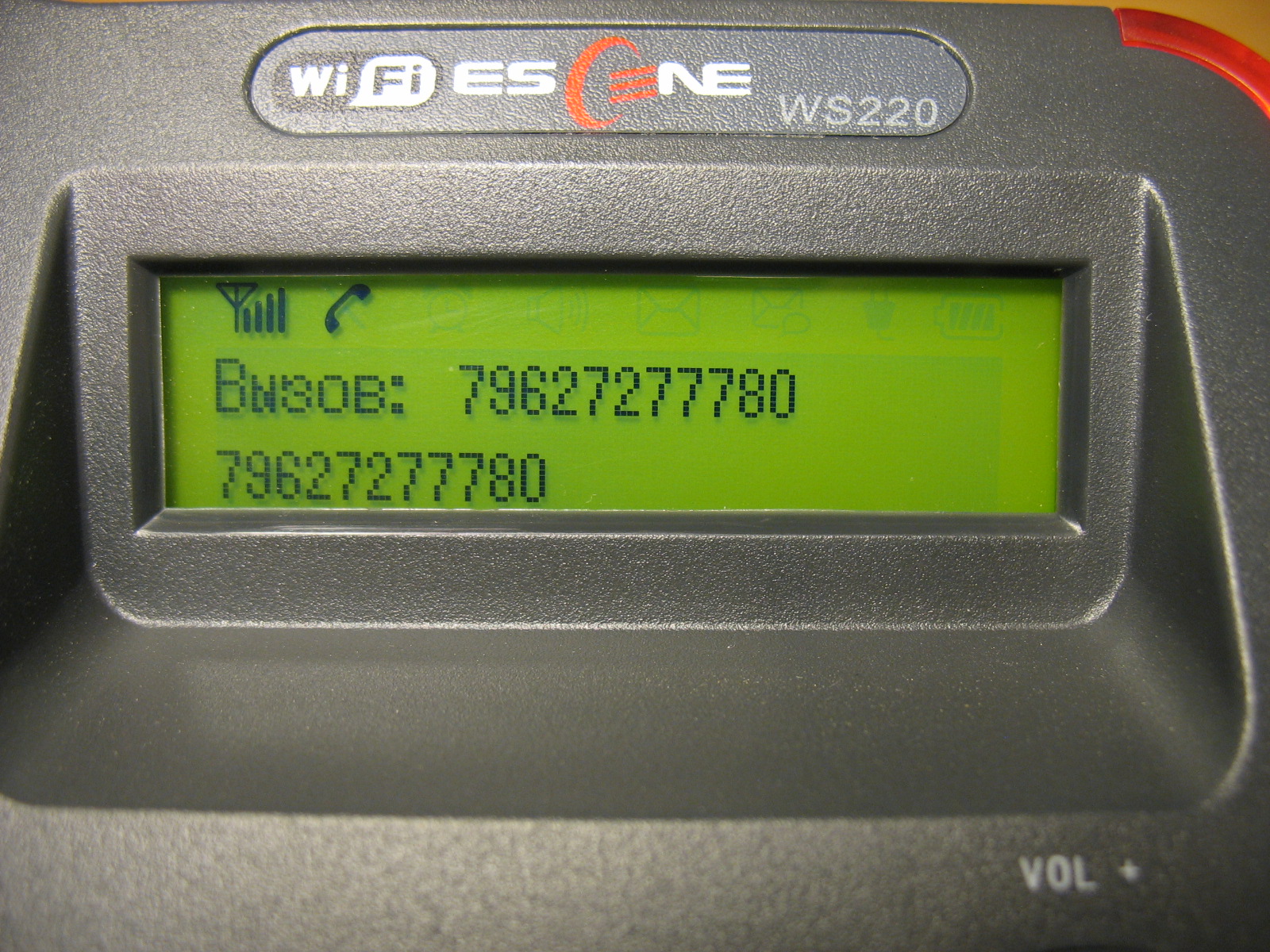
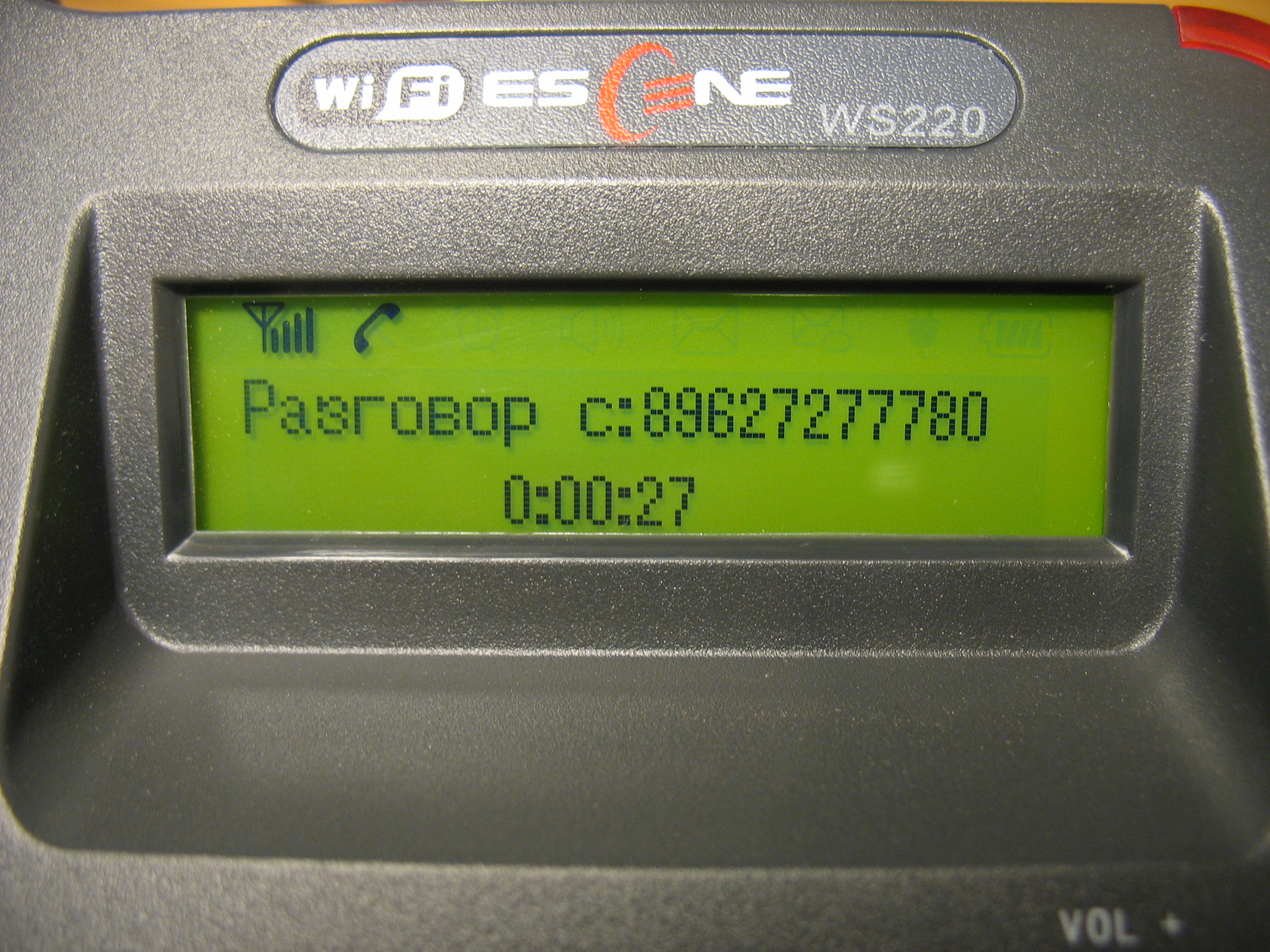

In addition to the sound signal and on-screen indications, when an incoming call is made, the diode of the corresponding line of the telephone and the red indicator lamp on the upper right corner of the phone blink.
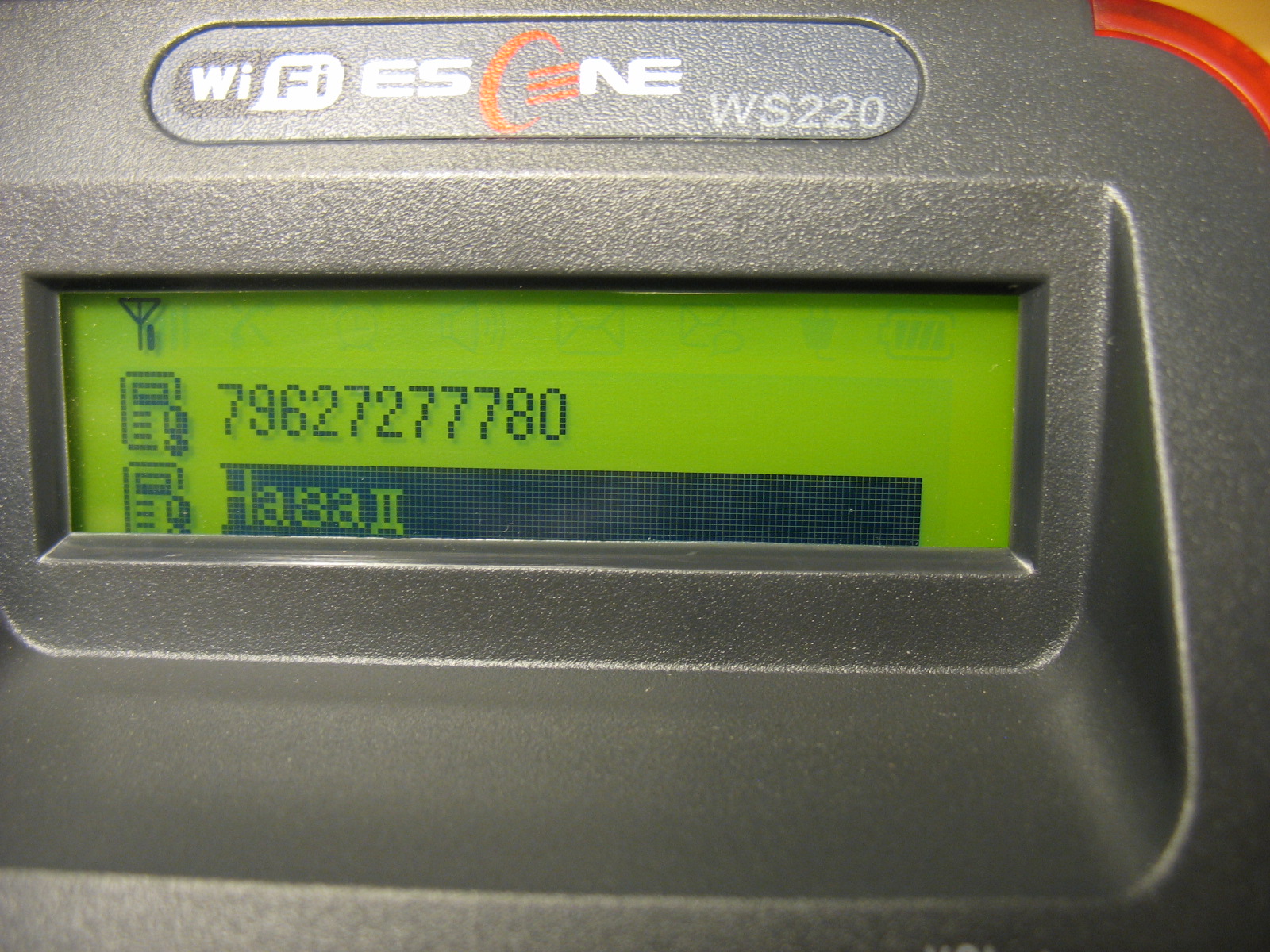
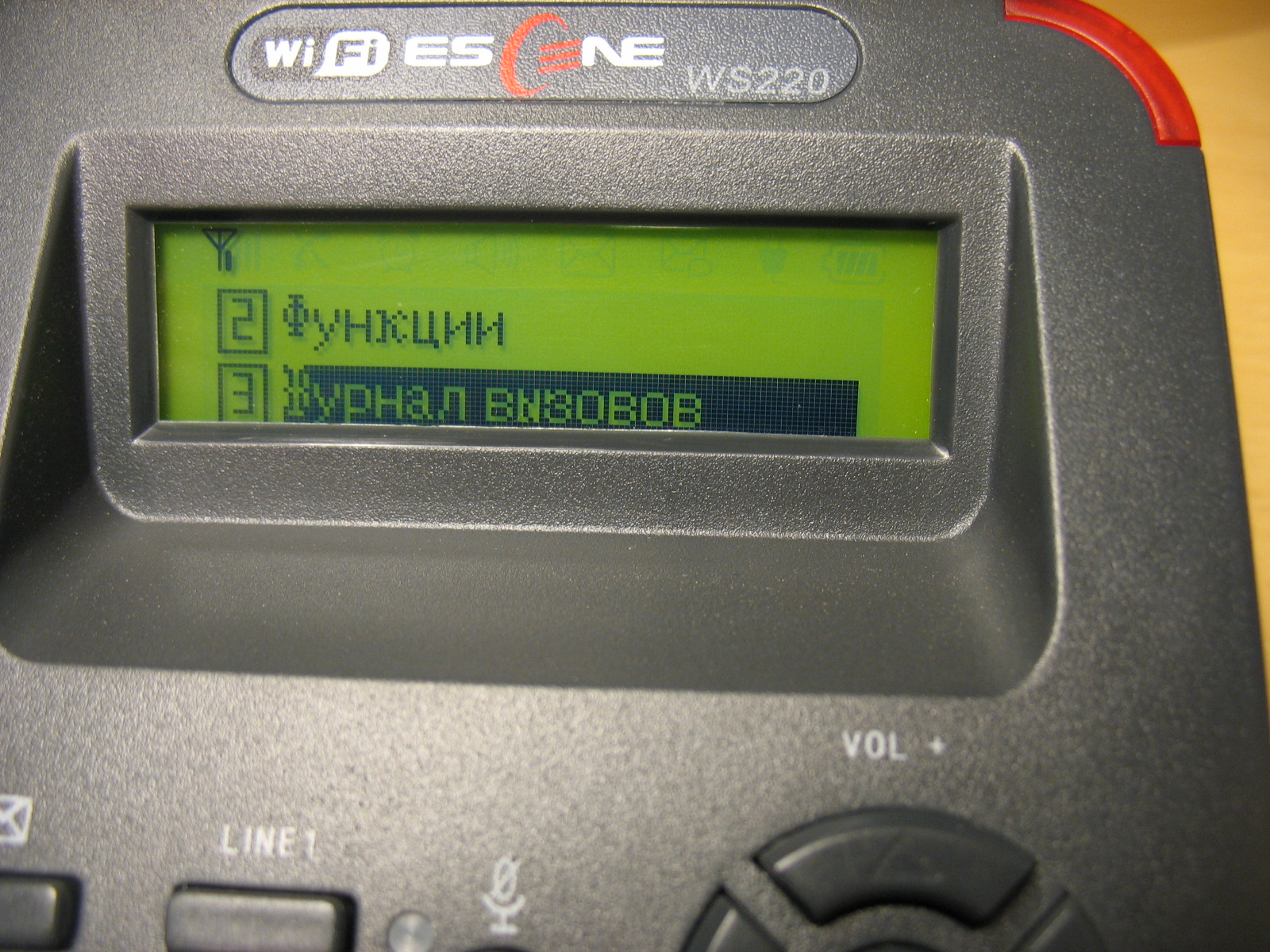
The phone can be configured either using the on-screen menu or using the web-based interface. Unlike most phones from other manufacturers, which leave a minimum of settings in the phone menu and a larger number only through the web interface, the Escene developers decided to make accessible from the phone menu in addition to the standard settings, also settings related to SIP accounts.
Such a move is fully justified, in some cases, you can configure the phone faster. In addition, sometimes there may be problems with access to the phone through a web-interface or it may be necessary to explain to an employee remotely how to reconfigure his phone. It will be easier for an unprepared person to use the phone menu, rather than a web interface.
You can connect to the phone in two ways:
Initial setup using phone buttons
So, we installed the phone, if necessary, connected a computer to it via the PC port. An access point or a Wi-Fi router to which the phone will be connected has access to a local area network (LAN).
Now we need to include the Russian language in the menu:
Click the "OK" button, it is located in the middle of the navigation button block, a menu will open. Use the Up or Down navigation buttons to navigate the menu, and the C button to return to the previous item. Next, press the number 1 (or the “OK” button), which corresponds to the choice of the “Language” menu, using the up or down navigation buttons select “Russian” and press the “OK” button. Then press the "C" button until you exit the menu.
Now you need to configure the network settings:
Click "OK", then select the "System Settings" menu (or press the number 6), number 2 - "Advanced Settings", the default password is empty, just click "OK". Next, select “Network”, then “LAN port”, by default, after the phone is loaded, the DHCP client is turned on, which is trying to get an IP address, therefore there should be a DHCP server on the network where the IP phone is located. If all settings are correct, the phone will receive an IP address and will be ready for further configuration.
If you need to use a static IP address, click the number 1 - “Type” and select “Static” and click “OK”. By default, the phone is configured with IP 192.168.0.200, to change the settings of the IP address, mask, gateway and DNS, use the menu buttons and navigation keys, after saving the settings, the phone will reboot. I note that in this menu “LAN port” you can configure the port for access to the web interface, by default it is 80, as well as the port for accessing the phone via telnet.
The LAN port on the phone has remained, but instead of the RJ-45 jack for connecting the cable, a plug is inserted, and the LAN port is connected to the Wi-Fi controller, the physical medium for transmission in this case is not the cable, but the wireless network, so it needs to be configured.
To configure the wireless network, click “OK”, then select the “System Settings” menu (or press the number 6), the number 2 - “Advanced settings”, the default password is empty, just click “OK”. Next, select item 7 - “Wi-Fi setup”, if necessary, in item 4 - “WPA / WPA2” set the AES or TKIP encryption algorithm. Next, select item 5 - “List of sites” and click “OK”, the phone will scan the broadcast, and the list of all available wireless networks with SSID will be displayed along with the signal strength, the higher the signal, the closer the wireless point is and the more sure will be welcome. Select the name of the wireless network to which you want to connect and click “OK”, the list of detected parameters of this wireless network will open, select any item and click “OK”, the “Key:” option will open using the keyboard and enter the network key. For example, the letter b will correspond to 4 pressing the “2” button on the telephone panel.
After the key has been entered, press the “OK” button, the message “Please wait ...” will appear on the screen.To make sure that the connection is successful, select menu item 3 - “Current site: NETWORK NAME” and click “OK”, in item 2 - “Status” the status “Connected” is displayed - the connection to this network was successfully established or “Disconnected” - connection to this network is not established.
If the SSID of the network to which you want to connect is not announced on the air, select the “Enter SSID manually” option, then in the appeared menu, specify the SSID manually in the “SSID:” menu item and the encryption type in the “Encryption type” menu item (WPA / WPA2 / WEP ), then, to connect to the network, select the menu item "Communication" to connect to this network with the specified settings.
Special attention is given to the setting of the PC port (Menu -> Settings -> Advanced Settings -> Network -> PC Port). Here you can configure the network operation mode between PC and LAN ports (working via Wi-Fi). In the “Bridge” mode, this is a two port switch. If you set the “Router” mode, the PC port is assigned an IP and a mask, the NAT address translation is enabled between the LAN and the PC, you can also enable the DHCP server. Thus, the phone also becomes a router with support for targeted NAT translation.
Now you need to check the correctness of the network settings and see the IP address that was assigned by DHCP, to do this, click "OK", select "Status", then number 7 - "View status", then "Network" menu, in my case IP address, assigned by DHCP: 192.168.1.27
Setting up additional phone features
All these settings are made in “Menu” -> “Functions”.
Auto Answer allows you to configure automatic answer to a call without lifting the handset.
DND allows you to reject all calls if the subscriber is busy.
VM number - set the number for access to voice mail (by default it is number * 97 - the standard number for accessing voice mail from the Asterisk distribution with FreePBX).
The hotline allows you to set automatic dialing of a given number immediately or with a set timeout.
Forwarding allows you to set conditional and unconditional forwarding to the specified numbers.
Support for additional services (DVO) and programmable buttons
The phone supports two independent SIP accounts, that is, registration on two different IP PBXs. At simultaneous registration of both lines, by default, the first line will be used. To switch to the second line (it should be configured) and return to the first one, use the “Line 1” and “Line 2” buttons.
I note that the phone supports two simultaneous calls, so to use simultaneous SIP registration on both lines in the SIP account settings for each line, you must set the "Number of lines used by the account" parameter to 1 (default value is 2). That is, the device supports only two lines, you can distribute them at your discretion - or assign both lines to the first SIP account or distribute one line to each SIP account and register both at the same time.
As for the DVO, they all work correctly:
To access the call logs, press the “OK” button, then the number 3 (corresponding to the “Call History” menu item).
Call log incoming calls and missed calls. Each log stores up to 20 recent calls.
To access the web interface from a computer with access to the network where the phone is located, enter the IP address of the phone in the address bar of the web browser, in my case it is 192.168.1.27
Default login and password:
root
root
There are two access levels on the phone:
It is advisable to change the password after the first authorization.
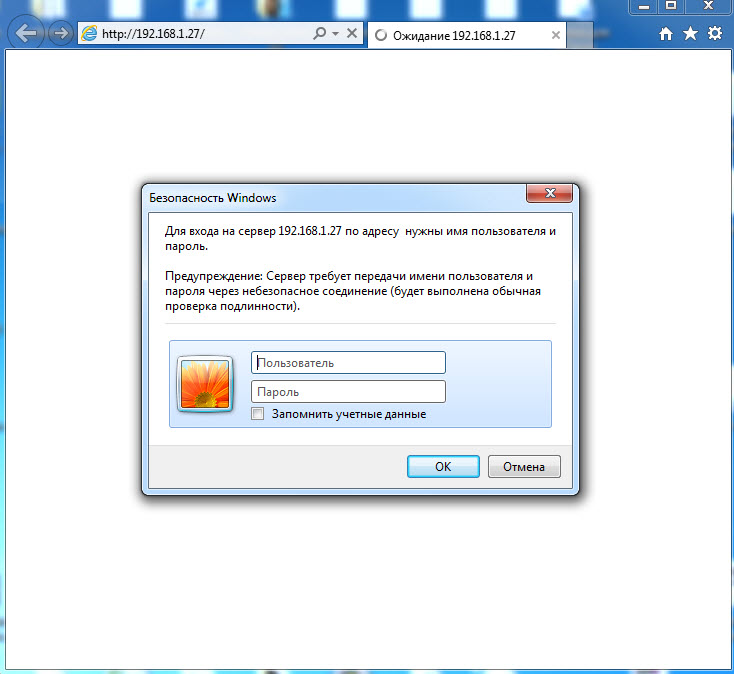
We get to the main menu of the web configurator of the phone. For convenience of setup, immediately select the Russian language in the lower left menu:

The menu is divided into several groups:

Consider the most important menu items phone.
These tabs will be discussed in more detail below.
W-Fi settings menu
Solutions to Wi-Fi connectivity issues
Menu "Network" -> "LAN port"
You can set one of three connection methods: DHCP, static IP, or PPPoE. An important setting is the HTTP and Telnet ports, they should be made non-standard if the phone is on an untrusted network (for example, with an external IP address on the Internet).




Menu "Network" -> "PC port"
L2 switching is switched on by default between the LAN and PC ports of the telephone - the “Bridge” mode. The phone can switch to L3 routing mode — a NAT address translation will start on the LAN port, an IP address will need to be configured on the PC port, and if necessary, a DHCP server must be enabled in which to set the pool of IP addresses for clients.
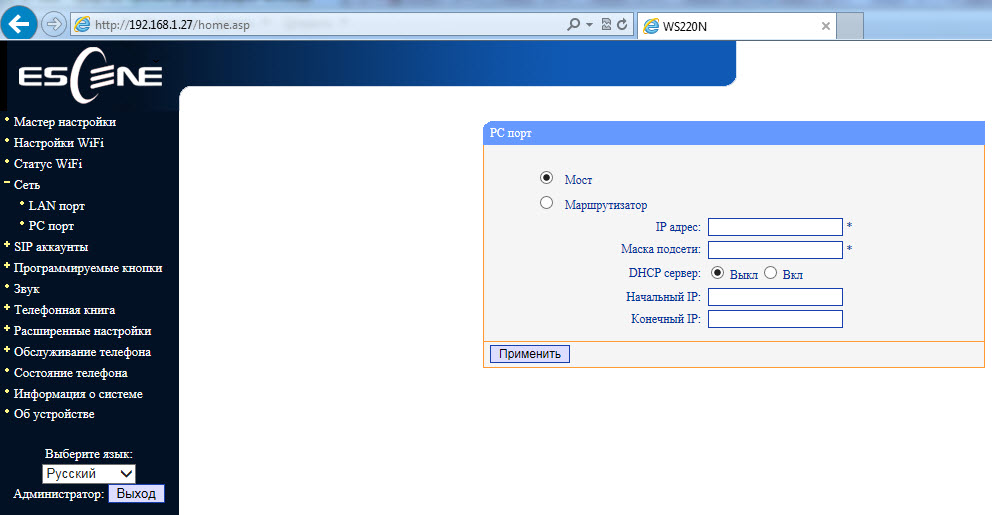
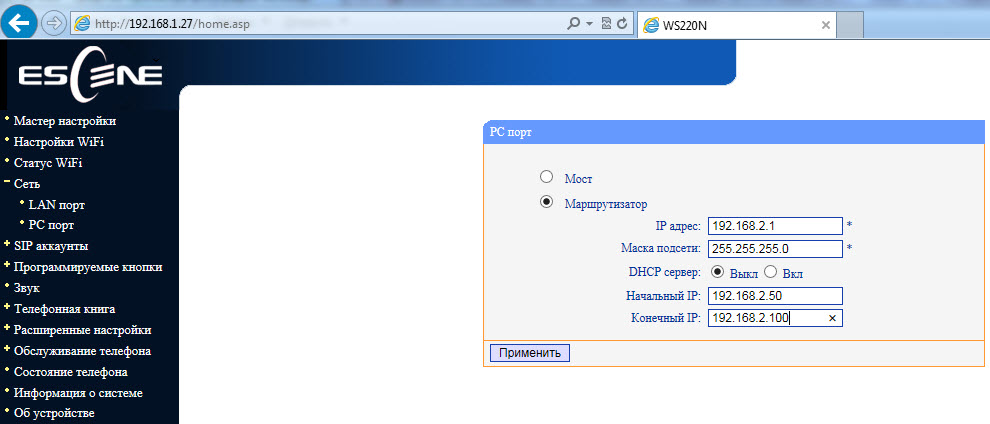
Menu "Advanced Settings" -> "VPN Settings"
VPN settings are in advanced settings, but since we are considering setting up the network, it is logical to mention it now.
If you need to connect your phone via a secure VPN channel, this can be done directly from the phone, without buying additional equipment (for example, a VPN router), the phone supports L2TP and SSL VPN. This is a very useful feature for several reasons.
Firstly, if you have several phones that need to be delivered to a remote office, there is no need to buy a VPN hub at each remote location, you only need to configure the VPN client built into the phone. Then through the tunnel to register his phone on the IP PBX in the central office.
Secondly, VPN improves security, more and more administrators are thinking about how to protect terminals that are on the Internet, two problems are becoming more acute - the danger of hacking the terminal and the difficulty of accessing telecoms operator engineers to configure it, because often the terminal is behind NAT. Using a VPN client solves both of these problems, so this useful feature will become increasingly popular.

VoIP Settings
The phone allows you to manage a large number of SIP signaling settings and settings for RTP media traffic.
Menu "SIP accounts" -> "Account 1"
In addition to the standard SIP account settings - User Name (UserID), Name (AuthID) and password, there is a “Label” field, it allows you to insert an arbitrary description of the line that will be displayed on the phone screen.
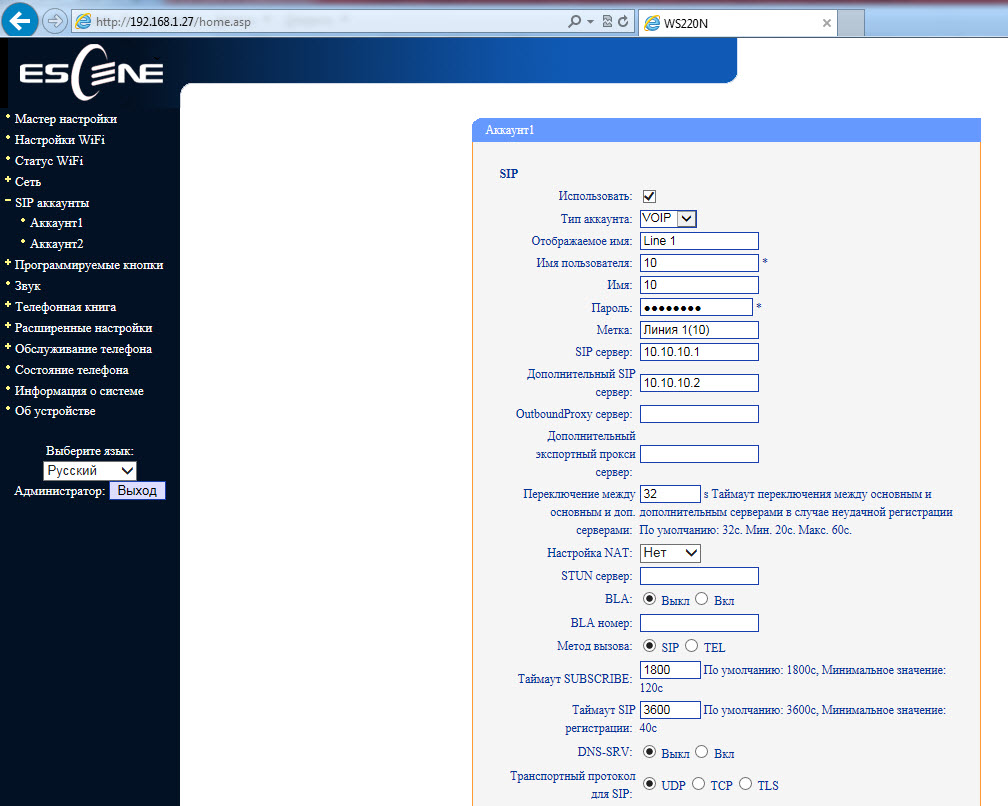
In addition to the main IP address of the SIP server, you can add an additional IP SIP server, in case of unsuccessful registration during the timeout, which is 32 seconds by default, its registration address will be used for the additional SIP server. The phone supports encryption of RTP and SIP signaling traffic using TLS protocol.

Sound menu
By default, when calling, the phone claims all possible codecs. If necessary, unused codecs can be disabled.
In the menu, you can adjust various volume parameters: handset, ringer, microphone, speakerphone. You can enable echo cancellation and VAD. Moreover, you can download your own ringtone.
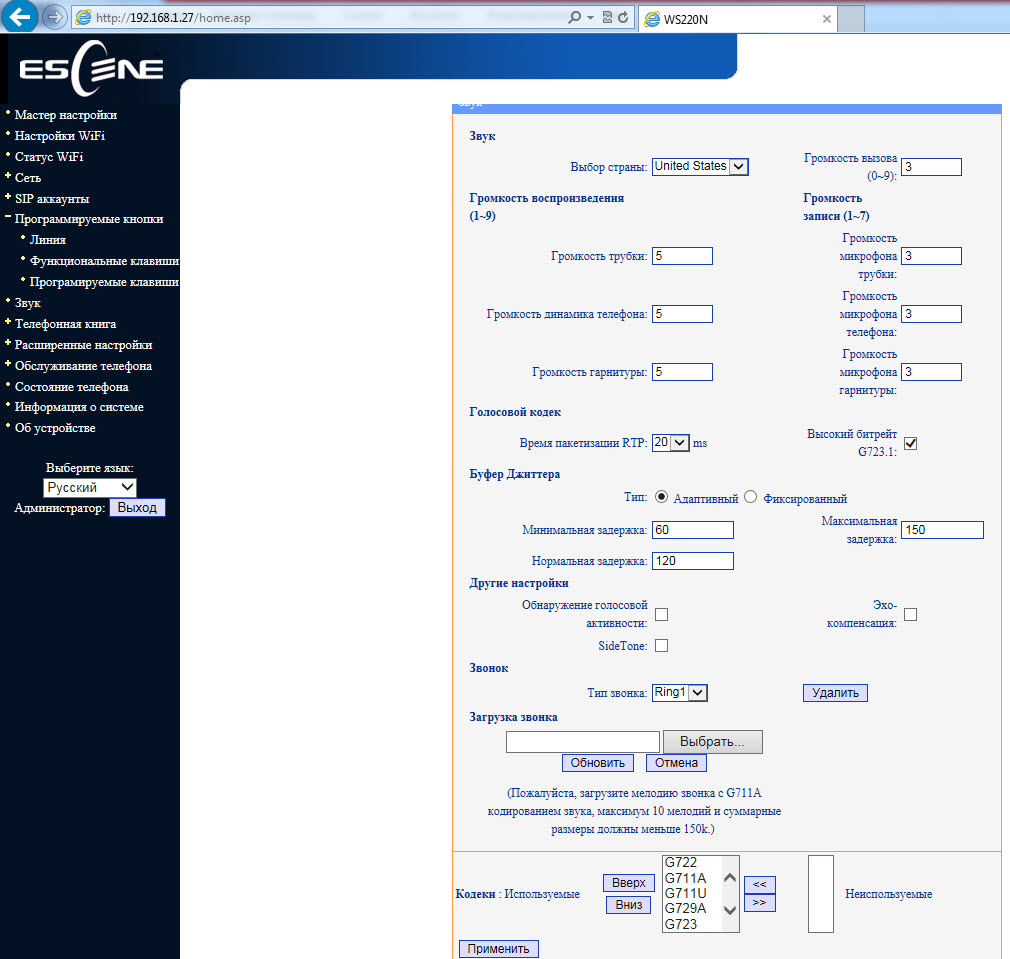
Menu "Advanced Settings" -> "Global SIP Settings"
If you set up the SIP settings here, they will be applied to both lines automatically, except for the settings “Local SIP port” and “RTP port range”, which can be useful for properly configuring the firewall.
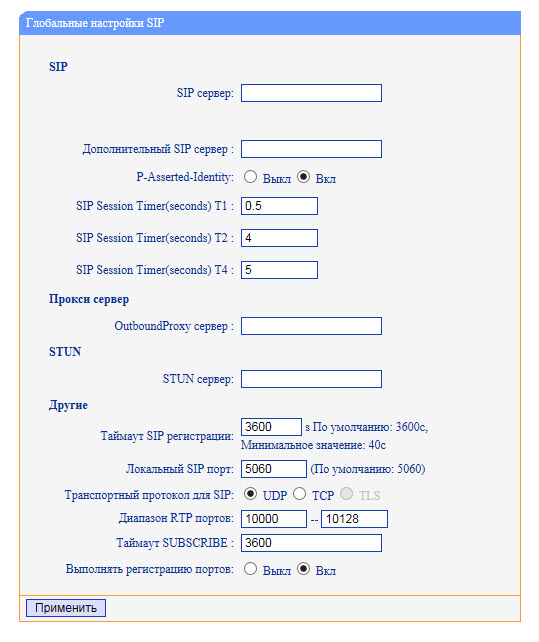
Menu "Advanced Settings" -> "Phone Settings"
In this menu, additional functions are configured. Such as “Hotline” - when you pick up the handset, the preset number is automatically dialed, you can turn on auto search in the address book during dialing and auto answer the call.
In case the call transfer is required to be performed with a special key combination (old code), instead of the standard SIP message 302, this can be specified in the setting “Special code for call transfer”. A useful setting that allows you not to break the connection in the conference, if it left the initiator. You can set call forwarding by condition (busy and “no answer”) and unconditional.
In this menu, you can configure codes that will be transmitted when you press the Pickup buttons (the value in the Call Pickup Code field) and Voice Mail (the value in the Voice Mail Number field).
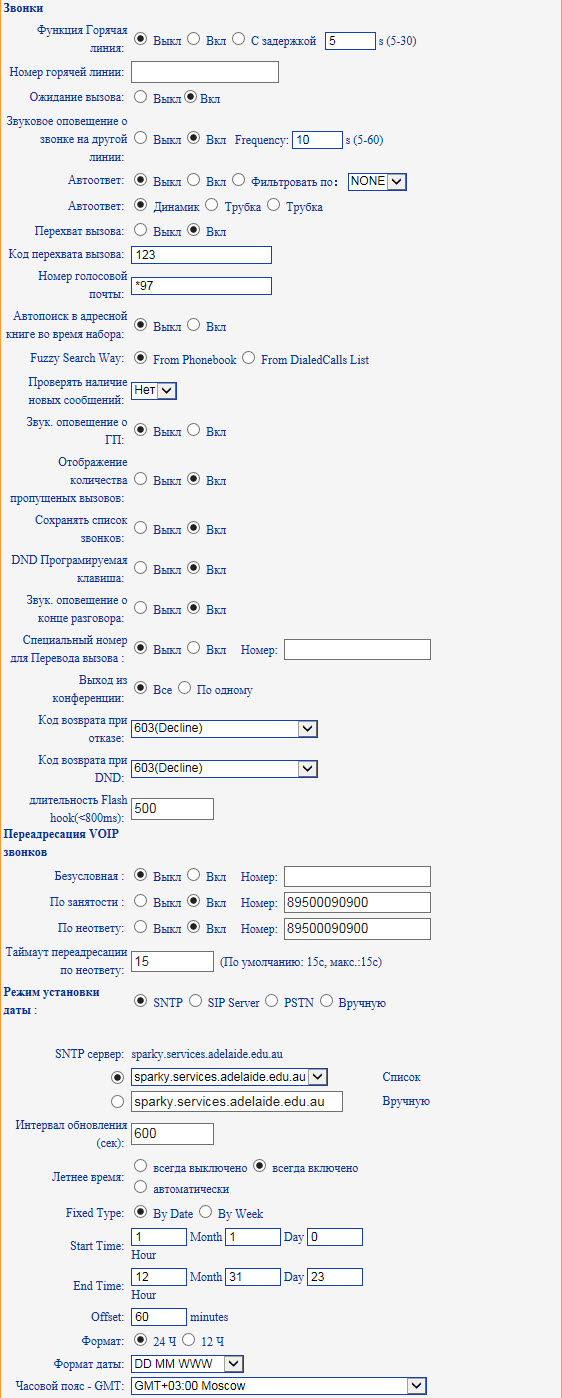
Menu "Phonebook"
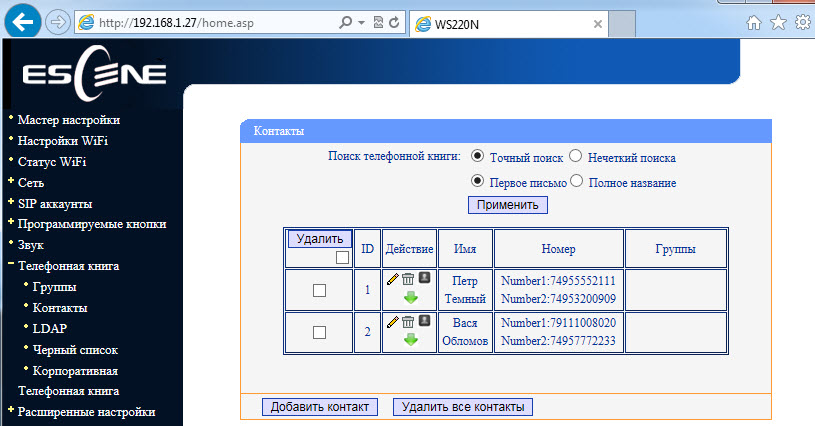
The phone has a built-in phone book, which is quite advanced. It allows you to store up to 300 contact entries, each of which can store up to 3 phone numbers. Entries can be made via the phone's on-screen menu using the web-based interface. To download or save the phone book in XML format, use the “Phone maintenance” menu -> “Update by HTTP” -> “XML Phone book”; here you can save or load the phone book in xml format.
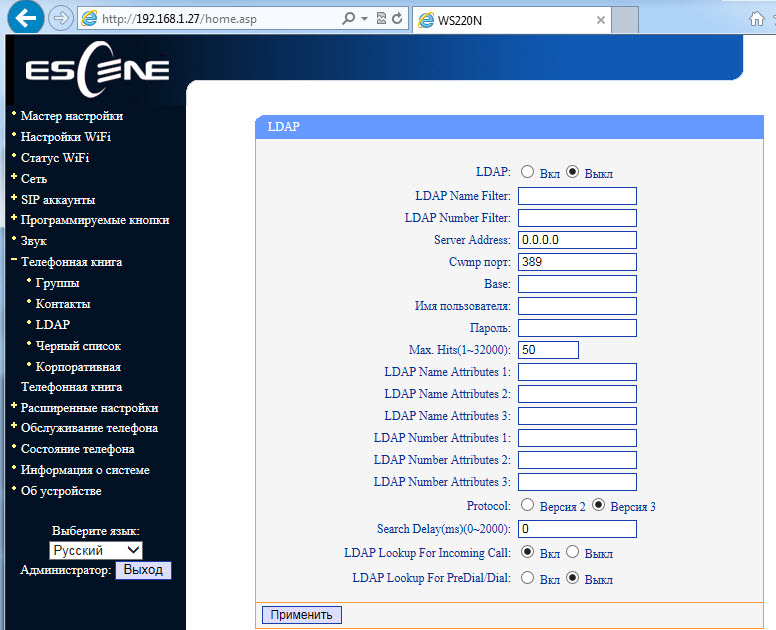
If your company uses an LDAP server, you can connect a phone to it and synchronize corporate contacts. 2 and 3 protocol versions are supported, as well as using the “LDAP Lookup For Incoming Call” and “LDAP Lookup For PreDial / Dial” settings, you can search for the contact name for an incoming and outgoing call, if the contact is in the LDAP directory, the number will be his name is automatically added.
The phone also supports blacklists or ban lists: an unwanted phone number is added to such a list and can no longer be reached.
Debug menu
To debug the phone, you can turn on logging by specifying the necessary logs (Menu “Phone maintenance” -> Log). You can view them in two ways:
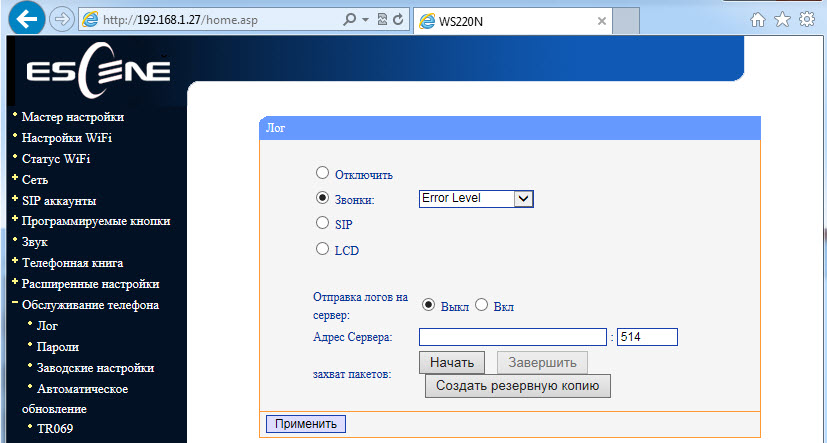
Menu "Phone maintenance" -> "Auto Provision" (Automatic update)
Using this menu, you can configure automatic downloading of configuration, firmware and address book to your phone. You can download one of several protocols: http / https / ftp / tftp.

Backup and Software Update
You can copy configuration files using three different protocols. FTP, TFTP and HTTP - the choice of a particular protocol is a matter of taste and convenience. Software update is extremely simple, you need to select the firmware file, then click update.
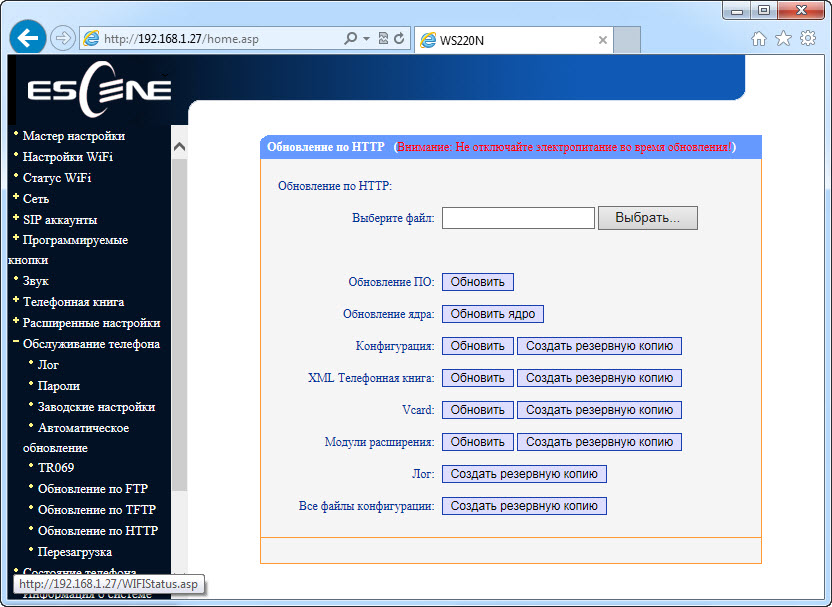
The status of the phone and system software can be viewed in the menu items "Status" and "System Information"

Suppose we need to configure two extensions (two SIP accounts). For example, the first entry on the IP PBX Asterisk, the second on the virtual IP PBX:
IP address of the server with Asterisk = 10.10.10.1
UserID = 10
password = QOXZuTcZ38qlBsr
SIP server (Asterisk) = 10.10.10.1
In the Asterisk sip.conf configuration, this will be equivalent to:
[ten]
deny = 0.0.0.0 / 0.0.0.0
secret = QOXZuTcZ38qlBsr
dtmfmode = rfc2833
canreinvite = no
context = from-internal
host = dynamic
type = friend
nat = yes
port = 5060
qualify = yes
callgroup = 01
pickupgroup = 01
allow = g722
dial = SIP / 10
mailbox = 10 @ device
permit = 0.0.0.0 / 0.0.0.0
callerid = device <10>
callcounter = yes
faxdetect = no
Equivalently, when configured in the Free-PBX web-interface, using the example of the first line:

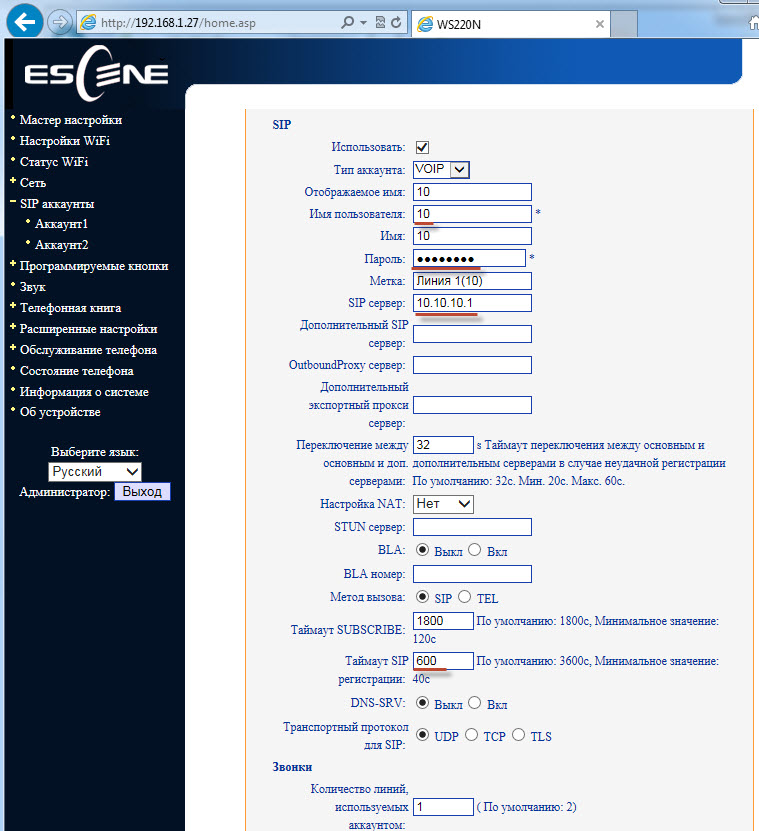
To work with Asterisk, just configure the Username (Username) = 10, password (Password) = QOXZuTcZ38qlBsr and SIP Server (SIP Server) = 10.10.10.1. You can add a label (Label) that will be displayed on the screen of the phone, in this case “Line 1”.
You can reduce the re-registration time from standard 3600 seconds to 600 seconds, this is especially true if the IP PBX is located outside the office, for example, Virtual PBX. If the phone is on a local network and the IP PBX is on the Internet, no special settings are usually required to overcome NAT. Next, click "Submit"
Exactly the same must be done with the second line, for example, city number 78126470011 on the SIP server West Call. Let's register it on a virtual PBX with a non-standard SIP port 9966:
userid = 78126470011
authid = 6470011
password = eIoMzKsf
sip proxy = uc.westcall.net
port = 9966

To specify a non-standard SIP port (other than 5060), you must explicitly specify it in the SIP server line: uc.westcall.net:9966 . Next, click the "Apply" button.
In case of successful registration, the corresponding display will appear on the phone screen, so information on the status of line registration is available on the Status menu page:
Account 1: Registered
Account 2: Registered
In order to use the DVO buttons (transfer, hold, conference) no additional configuration is required.
The phone is very attractive considering its cost and functionality.
Escene IP phones with Wi-Fi support creates a new model for the consumption of IP telephony services - thanks to the use of a wireless connection to the network, the devices have a high degree of mobility, and the time required for equipment deployment or dismantling is significantly reduced.
Key features of the phone include:
There were several reasons: high demands of voice traffic for quality of communication, and high cost of Wi-Fi solutions. The victorious march of the N standard and the substantial reduction in the cost of Wi-Fi modules made it possible to overcome these obstacles and offer another model of using an IP phone - the fixed wireless IP-phone Escene .

Today we look at the IP-phone Escence WS220-N , which opens up new possibilities for using VoIP, which were previously unavailable in fixed IP phones at a relatively low cost for a phone of this class.
The device is identical to the popular model of a series of corporate phones Escene ES220 , but has a key feature - the presence of a wireless network interface IEEE 802.11 b / g / n.
')
Connecting the phone to the network via Wi-Fi significantly increases the flexibility of the connection - increasing mobility and ease of telephony deployment. Using cordless phones to easily organize a workplace without wires, one can cite a lot of examples where connecting phones and workplaces over a wireless network is, if not the only way out, then a highly desirable option.
For example, the construction of a LAN (local area network) is impossible or undesirable, for economic reasons, or there is already a local area network. A good example is the need for high mobility and speed of network deployment to a working state. Also, the wireless connection of the workplace can be useful for aesthetic reasons, for example, a minimum of wires and objects in the workplace. When holding time-limited events, it’s easier, faster and more convenient to deploy a wireless network. If employees often move from office to office, transporting the “network with you” is just as easy using cordless phones.
Work at home is becoming more and more common: many people need a laptop and an IP phone connected to the network to complete the work. This is where the problem arises: if all laptops have been connected via Wi-Fi for a long time, the need to pull the wire from the router hanging in the hallway under the ceiling to the kitchen becomes a problem. This is where the landline Wi-Fi IP phone helps.
Of course, there are wireless solutions on the market - VoIP-DECT phones, but they are less convenient to work in a stationary workplace, and are intended for employees who move most of the time, for example, within the enterprise.
Using a Wi-Fi IP phone , you can connect any computer to the network, without laying cables to the workplace.
Stationary workplace - in this place the computer (desktop or laptop) does not have a wireless interface (Wi-Fi adapter), then the Ethernet network cable connects to the computer, on the other hand, the PC port of the wireless IP phone, then the phone connects via Wi-Fi to router or access point.
Mobile workplace - all devices in this place have wireless interfaces: a computer (desktop or laptop) and a wireless IP phone are connected via Wi-Fi to a router or access point.
As an IP PBX can be used either its own PBX or service provided by the provider.
IP PBX companies - software or hardware and software platform located in the company's office (for example, Asterisk, 3CX, etc.)
Cloud IP PBX - a platform located at a service provider (for example, MTT, Telphin, Mango, Tekmi, etc.)
Phone Escene WS220-N has an attractive appearance and a wide range of additional functions, while the product retains an attractive price. When developing phones, engineers and designers from Escence used a unified approach to design, functional characteristics, as well as to control interfaces. The line includes two models - basic and advanced, but they are united by similar features - they meet high requirements and have all the necessary functions of IP phones of the corporate level.
The Escene WS220-N phone is a basic model and is aimed at corporate consumers who place high demands on the appearance of the phones, the quality of workmanship and usability while maintaining a reasonable cost.

Features:
- Part of a single corporate level lineup.
- Wi-Fi support
- High quality body materials.
- High ergonomics.
- Suitable for contact center operations.
- Simplicity of setup due to the clear interface.
- Russified web-interface and on-screen menu.
- The ability to fully customize the phone using the screen and buttons, including SIP accounts.
- Ability to adapt the phone to work with SIP-compatible equipment.
- The functionality is more than most of the IP PBX and telecom operators currently support.
The cost of the model WS220-N is about 5,000 rubles, which is cheaper than counterparts from other manufacturers.
Functionality:
- Direct SIP connection to Virtual IP PBXs (for example, Broadworks, MFI RTU) and to office IP PBXs (for example, Asterisk, 3CX IP PBX, Avaya IP Office).
- LAN port with Wi-Fi wireless controller IEEE b / g / n
- The ability to work in the switching or routing mode between the PC and LAN ports (Wi-Fi connection)
- Easy installation and operation, advanced configuration options (including SIP and DVO functions) via the on-screen menu or via the web interface.
- Supports two simultaneous calls on two independent SIP accounts.
- Adaptation for the work of the operator in the contact center (ergonomics, an additional RJ11 connector for the headset of the operator of the contact center).
- Full duplex speakerphone, caller ID, call hold, call transfer and call forwarding, as well as other additional functions.
- High definition audio support Voice HD (G.722 codec).
- Built-in VPN client.
- Encryption of SIPS signaling and SRTP traffic media.
- Support for a corporate notebook using the LDAP or XML protocol or a personal notebook.
- Russified on-screen menu and web-interface phone.
- Specifications
Specifications
VoIP
- RFC 3261 standard SIP server, Asterisk, Avaya, Cisco, Broadsoft, RTU MFI, 3CX IP PBX, Panasonic SIP-PBX and others.
- Encryption of SIPS signaling traffic and SRTP media traffic.
- Audio codecs: G.711 u / a, G.722 (HD Voice), G.729a, G.723.
- QoS: TOS, Jiffer Buffer, VAD, CNG, G.168 (32ms).
- DNS SRV support.
- Two SIP accounts with the possibility of registration on two independent SIP servers and the possibility of automatic switching in case of loss of registration.
- Two simultaneous calls to the phone from any of the two SIP accounts.
Data transfer
- Wireless Wi-Fi controller (IEEE b / g / n, WPA / WPA2 and 64/128 bit WEP) on the LAN port
- 1 * RJ45 10 / 100M Ethernet (PC port)
- IP addressing: DHCP client or static IP destination.
- Built-in VPN client L2TP or SSL VPN.
- Network protocols HTTP, BOOTP, FTP, TFTP, IEEE 802.1Q, IEEE 802.1X.
Physical parameters
- Monochrome LCD screen with backlight and a resolution of 128x32 pixels.
- Call indicator light.
- Full duplex speaker and handsfree microphone.
- Two buttons for selecting line 1 and line 2.
- 6 navigation multifunction buttons (4 navigation buttons, the “OK” button and the button for deleting the “C” symbol).
- Buttons of additional services: conference, transfer, hold and intercept.
- "Speakerphone" button and redial.
- Voicemail button.
- Button to switch to the headset.
- Connector for RJ11 tube connection.
- Additional headset jack - the ability to connect a headset, supported headset for a contact center with an RJ11 connector.
Additional services (additional features)
- Waiting for a second call, a queue (if it supports an IP PBX), call transfer, call forwarding, call hold, call pickup, callback, call repetition, auto answer
- Speed dialing, button to start recording a conversation using the old code (if it supports IP PBX)
- Multilateral conference (if supports IP PBX), 3-party conference on the phone
- Do Not Disturb (DND)
- Voice mail (if the function is supported by IP PBX)
- Personal note book, corporate note book (LDAP or XML)
Control
- Protocols update: HTTP / TFTP / (PnP auto-tuning) PnP auto-provision.
- Configuration: via the phone's on-screen menu / web-interface / auto-provision.
- Debugging: telnet / phone screen / web-interface.
Nutrition
- An adapter model AD300 (AV 220/110 Volt, DC output voltage DC 5 Volt / 1.2A) is included in the package.
- Package, appearance and packaging
- Packaging
- The phone is delivered in a cardboard box that shows the company logo, on the side of the package there is a sticker with the model number and barcode of the device.


Phone kit


Inside the phone is neatly packed, there is nothing superfluous in the box, obviously, this equipment reduces the cost of the phone.
The box contains standard equipment, which includes:
- Telephone set.
- Handset.
- Handset cord.
- RJ45 patch cord to connect to the network.
- Instruction and warranty card.
- Power supply Escence AD300 in a carton.
Front panel and hardware buttons


Conventionally, the buttons on the phone can be divided into 3 blocks.
The first block is the management of lines and headset.
The phone has two independent SIP accounts (two SIP lines). By default, outgoing calls are established from line 1, if of course it is set up, if necessary to make a call from line 2, you need to click on the line button, then dial the number — the phone will send the call through the second SIP account. The phone can accept two simultaneous calls. Near the Line 1 and Line 2 buttons there is a light indication, when a call arrives, the diode of the line to which the call is being received lights up. There is a separate voice mail call button and a very useful button (the headset icon is displayed above it) to switch to the headset and back, the button also has an indicator light, which allows the operator to control whether the headset is on or off.
The second block is multifunctional navigation keys.
The block is used primarily for easy navigation through the menu, the “C” button is used to delete a character, it also turns off and turns on the microphone during a call. Using the Up and Down buttons, you can adjust the ring volume or the volume of the phone during a call.
The third block is the management of additional functions.
Here are all the necessary buttons, just the ones that are used most often:
- Conference - to create a 3-party conference (initiator, and two participants), to create a conference with a large number of participants, such a function must be supported on the IP PBX.
- Transfer - Transfer a call during a call.
- Hold / Pickup - during a call, when you press the button, the call will be put on hold; with an incoming call, the button allows you to intercept the call.
- Redial - redial the last number.
- Handsfree - turn on or off the speakerphone (speakerphone), it is full duplex in the phone.
Back of phone

On the back of the phone is a standard sticker with the model number, serial number and MAC address.
Phone Interfaces & Connectors




The left figure shows the side interface unit; there is a 5 volt socket on the panel for power supply from the AC network using the power adapter, and an RJ11 connector is used to connect the headset. Ethernet interface - PC for connecting the phone to a computer, there is a stub on the LAN port, as the LAN port is connected wirelessly. The picture on the right shows the RJ11 tube connector.

Here is the panel with the connected wires.
View of the phone on the table


This is how the phone looks assembled, high-quality plastic, the screen backlight is not very bright, but bright enough to easily read the messages on the screen.
Phone screen
The phone has a monochrome LCD screen with a backlight of 128 * 32 characters, not large, but its size is enough to easily read the information from the screen.

This is how the phone screen with the registered line in Russian looks. “Line 1 (10)” is an arbitrary label that is configured in the “SIP Accounts” menu and is called “Label”. The sign of the back arrow on the screen to the right means that the forwarding is set.
Dialing a number


Conversation state

Incoming call

In addition to the sound signal and on-screen indications, when an incoming call is made, the diode of the corresponding line of the telephone and the red indicator lamp on the upper right corner of the phone blink.
Call Lists

View of the menu on the phone screen

Phone setup
The phone can be configured either using the on-screen menu or using the web-based interface. Unlike most phones from other manufacturers, which leave a minimum of settings in the phone menu and a larger number only through the web interface, the Escene developers decided to make accessible from the phone menu in addition to the standard settings, also settings related to SIP accounts.
Such a move is fully justified, in some cases, you can configure the phone faster. In addition, sometimes there may be problems with access to the phone through a web-interface or it may be necessary to explain to an employee remotely how to reconfigure his phone. It will be easier for an unprepared person to use the phone menu, rather than a web interface.
You can connect to the phone in two ways:
- Connect to the phone via the PC port using a computer — by default, the phone is configured with a static IP address 192.168.0.200, and the PC port and LAN (Wi-Fi) work in the bridge mode.
- Using the phone buttons, configure the connection to the wireless network and connect to the phone through it.
Initial setup using phone buttons
So, we installed the phone, if necessary, connected a computer to it via the PC port. An access point or a Wi-Fi router to which the phone will be connected has access to a local area network (LAN).
Now we need to include the Russian language in the menu:
Click the "OK" button, it is located in the middle of the navigation button block, a menu will open. Use the Up or Down navigation buttons to navigate the menu, and the C button to return to the previous item. Next, press the number 1 (or the “OK” button), which corresponds to the choice of the “Language” menu, using the up or down navigation buttons select “Russian” and press the “OK” button. Then press the "C" button until you exit the menu.
Now you need to configure the network settings:
Click "OK", then select the "System Settings" menu (or press the number 6), number 2 - "Advanced Settings", the default password is empty, just click "OK". Next, select “Network”, then “LAN port”, by default, after the phone is loaded, the DHCP client is turned on, which is trying to get an IP address, therefore there should be a DHCP server on the network where the IP phone is located. If all settings are correct, the phone will receive an IP address and will be ready for further configuration.
If you need to use a static IP address, click the number 1 - “Type” and select “Static” and click “OK”. By default, the phone is configured with IP 192.168.0.200, to change the settings of the IP address, mask, gateway and DNS, use the menu buttons and navigation keys, after saving the settings, the phone will reboot. I note that in this menu “LAN port” you can configure the port for access to the web interface, by default it is 80, as well as the port for accessing the phone via telnet.
The LAN port on the phone has remained, but instead of the RJ-45 jack for connecting the cable, a plug is inserted, and the LAN port is connected to the Wi-Fi controller, the physical medium for transmission in this case is not the cable, but the wireless network, so it needs to be configured.
To configure the wireless network, click “OK”, then select the “System Settings” menu (or press the number 6), the number 2 - “Advanced settings”, the default password is empty, just click “OK”. Next, select item 7 - “Wi-Fi setup”, if necessary, in item 4 - “WPA / WPA2” set the AES or TKIP encryption algorithm. Next, select item 5 - “List of sites” and click “OK”, the phone will scan the broadcast, and the list of all available wireless networks with SSID will be displayed along with the signal strength, the higher the signal, the closer the wireless point is and the more sure will be welcome. Select the name of the wireless network to which you want to connect and click “OK”, the list of detected parameters of this wireless network will open, select any item and click “OK”, the “Key:” option will open using the keyboard and enter the network key. For example, the letter b will correspond to 4 pressing the “2” button on the telephone panel.
After the key has been entered, press the “OK” button, the message “Please wait ...” will appear on the screen.To make sure that the connection is successful, select menu item 3 - “Current site: NETWORK NAME” and click “OK”, in item 2 - “Status” the status “Connected” is displayed - the connection to this network was successfully established or “Disconnected” - connection to this network is not established.
If the SSID of the network to which you want to connect is not announced on the air, select the “Enter SSID manually” option, then in the appeared menu, specify the SSID manually in the “SSID:” menu item and the encryption type in the “Encryption type” menu item (WPA / WPA2 / WEP ), then, to connect to the network, select the menu item "Communication" to connect to this network with the specified settings.
Special attention is given to the setting of the PC port (Menu -> Settings -> Advanced Settings -> Network -> PC Port). Here you can configure the network operation mode between PC and LAN ports (working via Wi-Fi). In the “Bridge” mode, this is a two port switch. If you set the “Router” mode, the PC port is assigned an IP and a mask, the NAT address translation is enabled between the LAN and the PC, you can also enable the DHCP server. Thus, the phone also becomes a router with support for targeted NAT translation.
Now you need to check the correctness of the network settings and see the IP address that was assigned by DHCP, to do this, click "OK", select "Status", then number 7 - "View status", then "Network" menu, in my case IP address, assigned by DHCP: 192.168.1.27
Setting up additional phone features
All these settings are made in “Menu” -> “Functions”.
Auto Answer allows you to configure automatic answer to a call without lifting the handset.
DND allows you to reject all calls if the subscriber is busy.
VM number - set the number for access to voice mail (by default it is number * 97 - the standard number for accessing voice mail from the Asterisk distribution with FreePBX).
The hotline allows you to set automatic dialing of a given number immediately or with a set timeout.
Forwarding allows you to set conditional and unconditional forwarding to the specified numbers.
Support for additional services (DVO) and programmable buttons
The phone supports two independent SIP accounts, that is, registration on two different IP PBXs. At simultaneous registration of both lines, by default, the first line will be used. To switch to the second line (it should be configured) and return to the first one, use the “Line 1” and “Line 2” buttons.
I note that the phone supports two simultaneous calls, so to use simultaneous SIP registration on both lines in the SIP account settings for each line, you must set the "Number of lines used by the account" parameter to 1 (default value is 2). That is, the device supports only two lines, you can distribute them at your discretion - or assign both lines to the first SIP account or distribute one line to each SIP account and register both at the same time.
As for the DVO, they all work correctly:
- The Conference button allows you to transfer a call; call transfer is implemented using the SIP 302 Moved Temporarily message. This message today almost all IP PBX on the market.
- Transfer — , SIP 302 Moved Temporarily.
- Hold/Pickup . 123, web- « » -> « » « ».
- Redial – .
- Speakerphone button - allows you to turn on or off the speakerphone, answer a call with the speakerphone on, or end a call if the conversation is held over the speakerphone.
To access the call logs, press the “OK” button, then the number 3 (corresponding to the “Call History” menu item).
Call log incoming calls and missed calls. Each log stores up to 20 recent calls.
Web Interface Overview
To access the web interface from a computer with access to the network where the phone is located, enter the IP address of the phone in the address bar of the web browser, in my case it is 192.168.1.27
192.168.1.27Default login and password:
root
root
There are two access levels on the phone:
- admin level that can change any settings
- and a user who can perform a limited number of settings.
It is advisable to change the password after the first authorization.

We get to the main menu of the web configurator of the phone. For convenience of setup, immediately select the Russian language in the lower left menu:

The menu is divided into several groups:
- Network settings (wireless Wi-Fi, interfaces, VLAN, VPN, etc.)
- VoIP settings (SIP records and additional functions for signaling and media traffic)
- Settings for additional phone functions (phonebook settings, programmable buttons, dial plan, sound, etc.)
- Service settings (logging, reset and reboot, configuration management and software updates, etc.)

Consider the most important menu items phone.
- The “Setup Wizard” menu is used to quickly set up the phone, allows you to configure two tabs in sequence: the “Network” menu -> “LAN port” and the basic SIP account settings in the “SIP accounts” -> “Account1” menu.
These tabs will be discussed in more detail below.
Network settings
W-Fi settings menu
Solutions to Wi-Fi connectivity issues
Menu "Network" -> "LAN port"
You can set one of three connection methods: DHCP, static IP, or PPPoE. An important setting is the HTTP and Telnet ports, they should be made non-standard if the phone is on an untrusted network (for example, with an external IP address on the Internet).




Menu "Network" -> "PC port"
L2 switching is switched on by default between the LAN and PC ports of the telephone - the “Bridge” mode. The phone can switch to L3 routing mode — a NAT address translation will start on the LAN port, an IP address will need to be configured on the PC port, and if necessary, a DHCP server must be enabled in which to set the pool of IP addresses for clients.


Menu "Advanced Settings" -> "VPN Settings"
VPN settings are in advanced settings, but since we are considering setting up the network, it is logical to mention it now.
If you need to connect your phone via a secure VPN channel, this can be done directly from the phone, without buying additional equipment (for example, a VPN router), the phone supports L2TP and SSL VPN. This is a very useful feature for several reasons.
Firstly, if you have several phones that need to be delivered to a remote office, there is no need to buy a VPN hub at each remote location, you only need to configure the VPN client built into the phone. Then through the tunnel to register his phone on the IP PBX in the central office.
Secondly, VPN improves security, more and more administrators are thinking about how to protect terminals that are on the Internet, two problems are becoming more acute - the danger of hacking the terminal and the difficulty of accessing telecoms operator engineers to configure it, because often the terminal is behind NAT. Using a VPN client solves both of these problems, so this useful feature will become increasingly popular.

VoIP Settings
The phone allows you to manage a large number of SIP signaling settings and settings for RTP media traffic.
Menu "SIP accounts" -> "Account 1"
In addition to the standard SIP account settings - User Name (UserID), Name (AuthID) and password, there is a “Label” field, it allows you to insert an arbitrary description of the line that will be displayed on the phone screen.

In addition to the main IP address of the SIP server, you can add an additional IP SIP server, in case of unsuccessful registration during the timeout, which is 32 seconds by default, its registration address will be used for the additional SIP server. The phone supports encryption of RTP and SIP signaling traffic using TLS protocol.

Sound menu
By default, when calling, the phone claims all possible codecs. If necessary, unused codecs can be disabled.
In the menu, you can adjust various volume parameters: handset, ringer, microphone, speakerphone. You can enable echo cancellation and VAD. Moreover, you can download your own ringtone.

Menu "Advanced Settings" -> "Global SIP Settings"
If you set up the SIP settings here, they will be applied to both lines automatically, except for the settings “Local SIP port” and “RTP port range”, which can be useful for properly configuring the firewall.

Menu "Advanced Settings" -> "Phone Settings"
In this menu, additional functions are configured. Such as “Hotline” - when you pick up the handset, the preset number is automatically dialed, you can turn on auto search in the address book during dialing and auto answer the call.
In case the call transfer is required to be performed with a special key combination (old code), instead of the standard SIP message 302, this can be specified in the setting “Special code for call transfer”. A useful setting that allows you not to break the connection in the conference, if it left the initiator. You can set call forwarding by condition (busy and “no answer”) and unconditional.
In this menu, you can configure codes that will be transmitted when you press the Pickup buttons (the value in the Call Pickup Code field) and Voice Mail (the value in the Voice Mail Number field).

Menu "Phonebook"

The phone has a built-in phone book, which is quite advanced. It allows you to store up to 300 contact entries, each of which can store up to 3 phone numbers. Entries can be made via the phone's on-screen menu using the web-based interface. To download or save the phone book in XML format, use the “Phone maintenance” menu -> “Update by HTTP” -> “XML Phone book”; here you can save or load the phone book in xml format.

If your company uses an LDAP server, you can connect a phone to it and synchronize corporate contacts. 2 and 3 protocol versions are supported, as well as using the “LDAP Lookup For Incoming Call” and “LDAP Lookup For PreDial / Dial” settings, you can search for the contact name for an incoming and outgoing call, if the contact is in the LDAP directory, the number will be his name is automatically added.
The phone also supports blacklists or ban lists: an unwanted phone number is added to such a list and can no longer be reached.
Service Settings
Debug menu
To debug the phone, you can turn on logging by specifying the necessary logs (Menu “Phone maintenance” -> Log). You can view them in two ways:
- In the same menu, enable sending logs to the syslog server.
- In the “Phone maintenance” menu -> “HTTP update” download the file with logs.

Menu "Phone maintenance" -> "Auto Provision" (Automatic update)
Using this menu, you can configure automatic downloading of configuration, firmware and address book to your phone. You can download one of several protocols: http / https / ftp / tftp.

Backup and Software Update
You can copy configuration files using three different protocols. FTP, TFTP and HTTP - the choice of a particular protocol is a matter of taste and convenience. Software update is extremely simple, you need to select the firmware file, then click update.

The status of the phone and system software can be viewed in the menu items "Status" and "System Information"

Setting up connection to IP PBX Asterisk using web-interface
Suppose we need to configure two extensions (two SIP accounts). For example, the first entry on the IP PBX Asterisk, the second on the virtual IP PBX:
IP address of the server with Asterisk = 10.10.10.1
UserID = 10
password = QOXZuTcZ38qlBsr
SIP server (Asterisk) = 10.10.10.1
In the Asterisk sip.conf configuration, this will be equivalent to:
[ten]
deny = 0.0.0.0 / 0.0.0.0
secret = QOXZuTcZ38qlBsr
dtmfmode = rfc2833
canreinvite = no
context = from-internal
host = dynamic
type = friend
nat = yes
port = 5060
qualify = yes
callgroup = 01
pickupgroup = 01
allow = g722
dial = SIP / 10
mailbox = 10 @ device
permit = 0.0.0.0 / 0.0.0.0
callerid = device <10>
callcounter = yes
faxdetect = no
Equivalently, when configured in the Free-PBX web-interface, using the example of the first line:


To work with Asterisk, just configure the Username (Username) = 10, password (Password) = QOXZuTcZ38qlBsr and SIP Server (SIP Server) = 10.10.10.1. You can add a label (Label) that will be displayed on the screen of the phone, in this case “Line 1”.
You can reduce the re-registration time from standard 3600 seconds to 600 seconds, this is especially true if the IP PBX is located outside the office, for example, Virtual PBX. If the phone is on a local network and the IP PBX is on the Internet, no special settings are usually required to overcome NAT. Next, click "Submit"
Exactly the same must be done with the second line, for example, city number 78126470011 on the SIP server West Call. Let's register it on a virtual PBX with a non-standard SIP port 9966:
userid = 78126470011
authid = 6470011
password = eIoMzKsf
sip proxy = uc.westcall.net
port = 9966

To specify a non-standard SIP port (other than 5060), you must explicitly specify it in the SIP server line: uc.westcall.net:9966 . Next, click the "Apply" button.
In case of successful registration, the corresponding display will appear on the phone screen, so information on the status of line registration is available on the Status menu page:
Account 1: Registered
Account 2: Registered
In order to use the DVO buttons (transfer, hold, conference) no additional configuration is required.
findings
The phone is very attractive considering its cost and functionality.
Escene IP phones with Wi-Fi support creates a new model for the consumption of IP telephony services - thanks to the use of a wireless connection to the network, the devices have a high degree of mobility, and the time required for equipment deployment or dismantling is significantly reduced.
As for the model reviewed in the review: The WS220-N IP phone has a stylish appearance, high quality plastic and good ergonomics. The device is easily configured, the connection via Wi-Fi is stable, it does not lose SIP registration, it has good sound quality, additional functions (transfer, hold, forwarding, etc.) also work stably.
Key features of the phone include:
- Wireless network support Wi-Fi.
- Russified web-interface and on-screen menu.
- Support two independent SIP accounts per phone.
- Existence of additional Ethernet port for connection to the computer and an opportunity to work in the routing mode.
- Backlit LCD screen.
- The ability to configure in addition to network settings, SIP accounts, speed dial buttons and redirects directly from the phone screen.
- The presence of an additional RJ11 connector for connecting a headset.
- The price is lower than the competition.
Source: https://habr.com/ru/post/198688/
All Articles